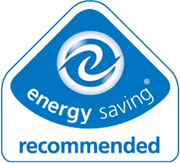There are quite a few Energy Efficient Accreditation Schemes that lend their logos or ratings graphs to products that help to improve the Energy Efficiency of the home. This article covers the five most common logos and rating graphs that you might come across.
These are ratings graphs and logos that help to identify the best of a certain type of products and encourage the home owner to partake of the product or service in the knowledge that it will help to save them money and help to reduce their carbon footprint on the environment.
Some schemes take a holistic approach to the whole building, some just for certain products or product ranges, but all of them are designed to help inform the purchaser of the best products for them or to point them in the direction of the best future improvements that they can make. So what are these schemes and what do they cover?
Energy Saving Recommended Logo
 This is potentially the most common logo you will come across, found on most household electronics and appliances. This logo is issued by the Energy Saving Trust and is only awarded to the most energy efficient products that they have tested and recommend.
This is potentially the most common logo you will come across, found on most household electronics and appliances. This logo is issued by the Energy Saving Trust and is only awarded to the most energy efficient products that they have tested and recommend.
The Energy Saving Trust website has a searchable database where you can look for products that have been tested and rated.
The Energy Performance Certificate
You might be aware of the multi-coloured ratings graph from estate agents details, but there is a full report behind this which consumers rarely get to see. The energy performance certificate ratings graph provides accurate information on how energy efficient a whole house is and what could potentially be done to the property. In the main report there are the specific measures that make up the ‘potential’ column included in a recommendations section. This is invaluable information if you are looking to know where to begin with improvement measures to your house and roughly what the costs and savings might be.
SEDBUK Labels
All boilers installed in the UK having ratings that are covered under the Seasonal Efficiency of Domestic Boilers or SEDBUK. This is a main database that carries information on all modern boilers as to their efficiency and allows for comparisons between different models, manufacturers and fuel types. Only the most efficient boilers carry an Energy Saving Recommended logo. The more efficient the boiler, the less fuel it uses to operate correctly in your home.
BFRC Window Energy Rating
The BFRC energy rating is a voluntary scheme used in the glazing installation and manufacture industry. The whole window, frame and glass, is rated based on the thermal efficiency, or how well it helps to retain heat. The best products will likely be Low E or Low Emissivity designed to keep heat in for longer. These products will likely also display the Energy Saving Recommended logo too. There are other schemes but this is the most common.
The European Union (EU) Energy Label
This label can be found on all appliances and tells the consumer detailed information on the potential product, including the exact energy consumption of the product. This has to be shown by law on all household white goods, such as fridges, freezers and washing machines, as well as on electric ovens. It’s even on light bulb packaging! The European Union are even acting on the results of these ratings and are looking to remove the least efficient models from sale. For example, since 1999, manufacturers have had to stop making fridges and freezers below of a D rating or below.
These are the most common schemes you will find on Energy Efficiency. Most of these graphs run on a very similar basis from A – G with A being the most energy efficient and G being the least. This information is invaluable in helping a home owner or consumer to make informed decisions that are right for them and hopefully will save them money. Every little helps, right? Making sure you use the information you are given will should make things easier in the future!
Written by Symon Silvester
Ok great post i found here
i want to say the bigger money-saving moves builders are making is to install more energy efficient appliances in new construction homes. Likewise, homeowners who are staying in their existing homes are trading in their energy-gobbling old appliances for the sleek new energy-efficient models.